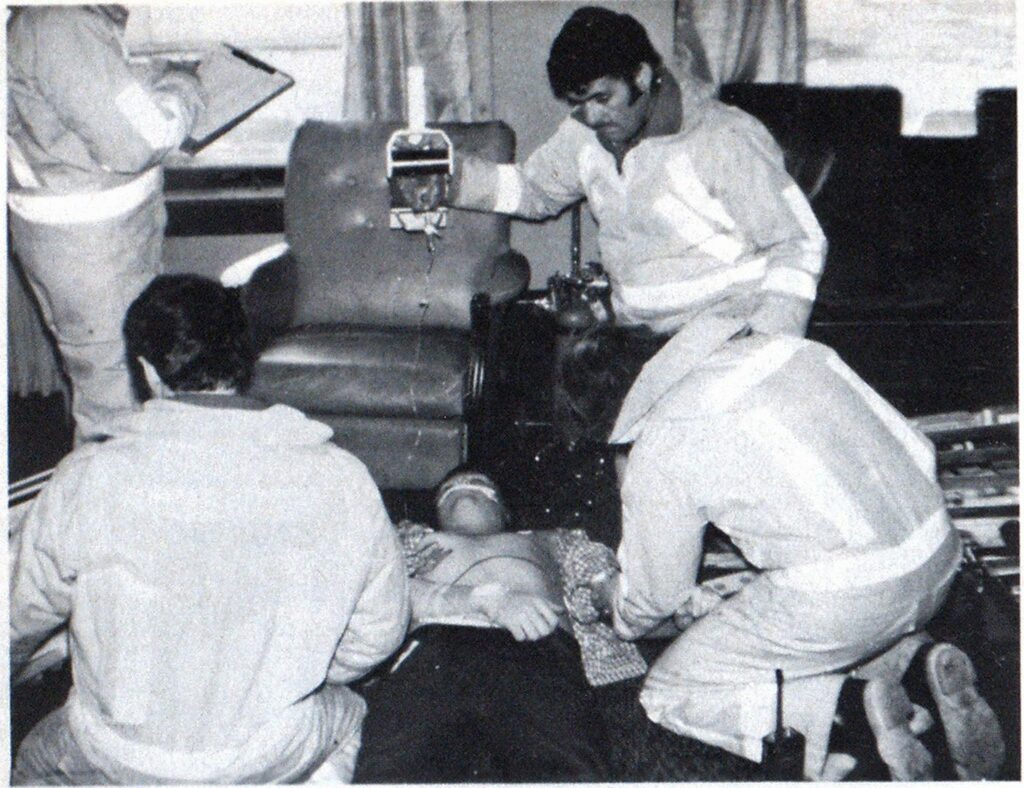
High-Visibility Jump Suits Protect Men, Look Smart
features

—photos by the author.
New jump suits used since May 1977 by the Owego Fire Department Emergency Squad in Tioga County, N.Y., are among the first protective garments of their kind to be worn in the United States. A prototype of future fire fighting wear, the jump suits are a radical departure from the fire department’s old coveralls and traditional bunker coats.
The one-piece suits of 7 1/2-ounce Nomex will be available nationally with unlined shells and lined full protection models. The lining is quilted Nomex with a vapor barrier. The lined suit is designed to meet NFPA standard 1971 for protective clothing for structural fire fighting and is superior in its safety characteristics.
The suits now in use by the Owego squad are a high visibility lime yellow color, combined with a novel and progressive retroreflective/fluorescent orange fabric layout. The combination provides high visibility both day and night. A variety of reasons were behind the development of the suit. Many departments have argued that the use of coveralls, while convenient and inexpensive, does not always provide sufficient protection for rescue and fire personnel. Others felt that jump suits for fire fighters, rescue men, or paramedics/fire fighters, should look more professional than the non-emergency private sector repairmen’s, mechanic’s or janitor’s clothing.
Some innovators within the fire service pointed out that the traditional high boots and bunker coats had limitations, among them the bulkiness of the traditional gear. Coats and bunker pants provide more protection than coats and boots, but they are worn less frequently as a combination because of weight, inconvenience and mobility factors. With a coat and boot arrangement, the lower coat can actually act as an inverted funnel to channel heat, smoke, and flames under the protective coat and into the body areas instead of providing a barrier to shut them out.
A large-size, fully lined, Nomex skin jump suit weighs about 7 pounds while bunker pants and coat similarly fabricated weigh 9 pounds.
Development of the suit was sponsored by the Janesville Fire Clothing Division of Lion Uniform and the 3M Company of St. Paul. The Nomex fabric, which is dyed a high visibility yellow, is sold under the brand name of Lion Lime The author worked with both companies for the design of the suit and other technical considerations.
3M provided scientific input and material for the retroreflective/fluorescent tape design, established for 360-degree retroreflective/fluorescent visibility. The basic principles of this design were developed directly from “Visibility of Fire Fighters,” Journal of the American Optometric Association, February 1974.
The advantages of the one-piece design are quite evident. First and foremost is the protection of the wearer. This has been discussed above but bears amplification. The environment in which we work as fire fighters is extremely harsh and unforgiving. With fire fighters, some degree of control can be exercised both through officer awareness and union activity, as well as individual training. Unfortunately all too many men still answer alarms inadequately protected. One of the strong jump suit values is that in one stroke, a man can be completely encompassed and have the same amount of protection that bunker pants and coats provide. The older protective items are much more clumsy to don, weigh more and allow hot gases to go under the coat toward the upper torso.

While ease of suiting up is important, so is mobility. The jump suit design allows greater freedom of movement. There are several reasons for this.
First, the jump suit is devoid of external buckles, so snagging on equipment or obstacles is reduced.
Second, the suit is trimmer and less bulky, so greater maneuverability is attained.
Third, with decreased garment weight, fatigue is less of a problem. When these aspects are reviewed, it can be seen that this approach to fire fighting greatly increases safety.
At the expense of repeating myself, I feel one of the most important factors is the ease of speed in which the wearer can put on a jump suit. You can have the best equipment available, but if the men don’t wear it, their safety is at stake.
Aside from the characteristics already discussed, the visibility factor must be considered. By using yellow Nomex and retroreflective/fluorescent tape patterns, the fire fighters’ safety is further enhanced.
The cost of a fully lined Nomex jump suit with retroreflective/fluorescent material is less than a two-piece fire fighter suit (coat and bunker pants) of similar construction.
The one recommendation for future designs that 1 feel is important for either jump suits or bunker pants is that a tight barrier be provided at ankle level to further limit the entry of noxious fumes and heat. With the existing snug fit between pant leg and boot, it is not a major problem and a simple modification would suffice.
The one major piece of gear that still needs rethinking is the fire boot. A design is needed that provides the ease of putting on the traditional boot, yet gives greater foot support for the wider range of fire fighter responsibility and more dynamic insulation for protection.
The thrust of increased safety is rapidly being felt in the fire service. In this most hazardous of all professions, the fire fighter needs all the protection he can get. At the same time, innovations must allow him to work more efficiently and not weigh him down.

